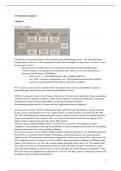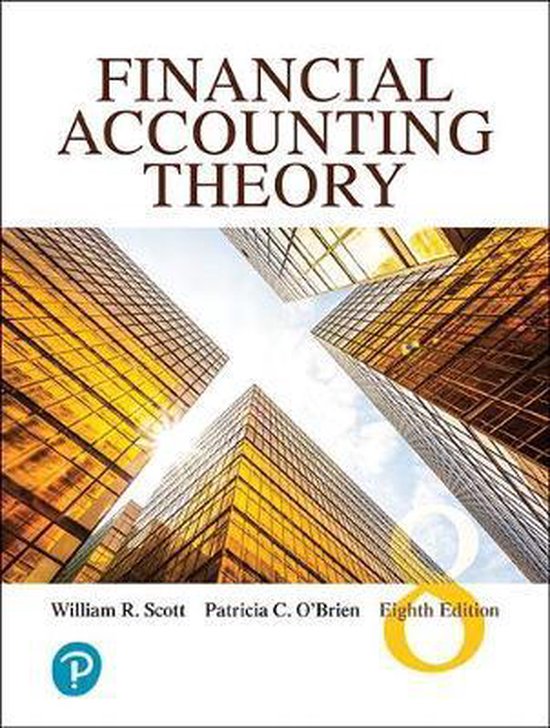AG literature summary
Chapter 1
Overview chapter 1:
The history of accounting begins with the double-entry bookkeeping system. This spread through
Europe, and we still use it. The measurement systems have changed over time. Now, we have a mixed
measurement system:
- Historical cost is primary basis of accounting for important asset and liability classes
- Current valuations are introduced into historical cost. Main current value alternatives to
historical cost for assets and liabilities:
o Value in use: i.e., discounted present value of future cash flows
o Fair value: exit price or opportunity cost. The hypothetical amount that would be
received or paid should the firm dispose of the asset or liability
Well-working capital markets: markets where the market value of assets and liabilities equal (or
reasonably approximate) the realm underlying fundamental values
IASB’s Conceptual Framework of Financial Reporting: the most recent statement of basic accounting
concepts, based on decision usefulness. States that the objective of financial statements is to provide
information to assist investors and creditors in making investment decisions.
Accounting principles tend to be vague, and their application requires judgment.
Special purpose entities (SPEs): limited partnerships formed for specific purposes. Largely financed
by the creator’s contributions of its own common stock, in return for notes receivable from the SPE.
The SPE could then borrow money using the creator’s stock as security, and use the borrowed cash to
repay its note payable to the creator. In this way, much of the creator’s debt does not appear in the
balance sheet. It appeared on the books of the SPEs instead.
This went wrong, and the Sarbanes-Oxley Act (SOX) was created. It was designed to restore
confidence in accounting by reducing the probability of such accounting horror stories. So, accounting
standard settings moved to restore public confidence
Structured investment vehicles (SIVs): SPEs created by financial institutions. The financial institutions
created SIVs to securitize their holdings of mortgages, credit card balances, auto loans and other
financial assets. The institution would transfer large pools of these assets to the SIVs it sponsored. The
SIV would then issue asset-backed securities (ABSs), often separated into tranches of different credit
quality. Frist-trance was very low risk, second-tranche somewhat riskier and so on. The tranches that
were sold to investors were marketed as having very low risk. Often, the ISV or its sponsor would
retain the riskier tranche, to help convince investors that the firm stood behind the investments it sold.
With SIVs there was apparent diversification of credit risk: risk that a party to a financial contract will
be unable to meet its financial obligations.
1
,ABSs were frequently further securitized as collateralized debt obligations (CDOs): consisted of
tranches of various ABS tranches, a procedure that further increased both diversification and leverage.
CDOs tended to be arranged and sold privately, and often consisted of riskier mortgages or other
assets.
To further increase the perceived safety, SIVs often added various credit enhancements (amounted to
purchased insurance against losses)
Variable interest entities (VIE): particular form of SIVs, where the primary beneficiary must
consolidated it in the balance statement. But many sponsors avoided consolidation by creating new
securities such as expected loss notes (ELNs): securities sold by sponsors to an outside party, under
which that party contracted to absorb a majority of a VIE’s expected losses and receive a majority of
expected net returns, thereby becoming the primary beneficiary under FIN 46.
In 2007, the whole structure came crashing down. Main contributions:
- Liquidity risk: can result in a market value less than value in use
- Counterparty risk: credit enhancement contracts, of which the dominant type was credit
default swaps (CDSs) were privately arranged and traded. So no regulations and no knowledge
of who held them.
- Wealth inequality and global imbalances in consumption, trade, and foreign exchange markets
Liquidity pricing: an outcome of liquidity risk, under which market value is less than value in use that
the institutions felt they would eventually realize if they held these assets to maturity.
Relatively unregulated capital markets are subject to catastrophic market failure.
Learning points for accountants from 2008 financial crisis:
- Financial reporting must be transparent
- Fair value accounting may understate value in use when markets collapse due to liquidity
pricing
- Off-balance sheet activities should be fully reported since they can encourage excessive risk-
taking by management
- Substantial changes to accounting standards and other regulations have taken place
Efficient contracting approach: argues that the contracts that firms enter into create a primary source
of demand for accounting information. The role of accounting information is to help maximize
contract efficiency. Or, more generally, to aid in efficient corporate governance. It emphasizes
reliability of accounting numbers. And it uses conservatism.
Stewardship role of financial reporting: alignment of manger and investor interests.
Society’s welfare depends on cooperation, and for that people need mutual self-interest. This requires
a long-run view. Something that can accomplish this is ethical behavior: do the right thing. SO,
accountants and auditors behave with integrity and independence, putting public interest ahead of that
of the employer and client.
Types of accounting standards:
- Rules-based accounting standards: detailed rules
- Principles-based accounting standards: general principles. Relies on auditor professional
judgment to ensure that application of the standards is not misleading.
Two roles of accounting research:
- Consider the effect of research on accounting practice
- Improve understanding of the accounting environment
Types of information asymmetry:
- Adverse selection: one or more parties to a business transaction, or potential transaction, have
an information advantage over other parties
2
, - Moral hazard: one or more parties to a contract can observe their actions in fulfillment of the
contract but other parties cannot
The fundamental problem of financial accounting theory: how to design and implement concepts and
standards that best combine two competing roles for accounting information: informing investors, and
improving contracting efficiency by motivating and evaluating manager performance. Reactions to
this problem:
- Tradeoff
- Reconciling: with other comprehensive income: includes unrealized current value gains and
losses resulting from fair value accounting. Comprehensive income: net income + other
comprehensive income
- Ignore the problem: keep regulation to a minimum needed to provide a stable environment for
trade, resolution of disputes, and punishment for wrongdoing
- Turn regulation to protect investors
Main components of the book:
- Ideal conditions: what accounting would be like under ideal conditions. Ideal or first-best
conditions: future cash flows are known and there are fair and efficient working markets. They
provide a benchmark against more realistic “second-best” accounting conditions.
- Adverse selection
- Moral hazard
- Standard setting. Important standard-setting bodies:
o International Accounting Standards Board (IASB):
Objective: develop a single set of high-quality, understandable, and
enforceable global accounting standards, now called International Financial
Reporting Standards (IFRS)
Members: 16
Oversight: International Financial Reporting Standards Foundation (IFRS
Foundation) as a governing organization
New standard: requires super-majority vote by 10 of the 16 members
Designing standards: according to due process
o Financial Accounting Standards Board (FASB):
Objective: U.S. standard setting form earlier bodies
Oversight: Financial Accounting Foundation (FAF)
New standard: emphasis on due process and broad consultation
o Canadian Accounting Standards Board (AcSB)
Objective: provide input to the IASB and develop standards for non-public
Canadian businesses and not-for-profit entities
Members: 11
New standards: due process
o Securities commissions: several commissions
Adhere to GAAP and issue accounting standards
Oversight: International Organization of Securities Commissions (IOSCO)
Chapter 2
Overview:
3






